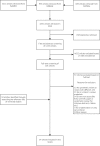Antimicrobial approaches in the prevention of Staphylococcus aureus infections: a review
- PMID: 30376041
- PMCID: PMC6337897
- DOI: 10.1093/jac/dky421
Antimicrobial approaches in the prevention of Staphylococcus aureus infections: a review
Abstract
Background: The prophylactic application of antimicrobials that are active against Staphylococcus aureus can prevent infections. However, implementation in clinical practice is limited. We have reviewed antimicrobial approaches for the prevention of S. aureus infections.
Methods: We searched the Cochrane Central Register of Controlled Trials, PubMed/MEDLINE and EMBASE databases and trial registries using synonyms for S. aureus, infections and prevention as search terms. We included randomized controlled trials and systematic reviews only.
Results: Most studies were conducted with mupirocin. Mupirocin is effective in preventing S. aureus infections in patients receiving dialysis treatment and in surgical patients, particularly if the patients are carriers of S. aureus. The combination of mupirocin and chlorhexidine, but not chlorhexidine alone, is also effective against S. aureus infections. So far, vaccines have not proven successful in protecting against S. aureus infections. Regarding prophylactic povidone-iodine and systemic antibiotics, there is limited evidence supporting their effectiveness against S. aureus infections. Antimicrobial honey has not been proven to be more effective or non-inferior to mupirocin in protecting against S. aureus infections.
Conclusions: The current evidence supports the use of mupirocin as prophylaxis for preventing infections with S. aureus, particularly in carriers and in the surgical setting or in patients receiving dialysis treatment. Other antimicrobial agents have not been sufficiently proven to be effective so far, or have been proven ineffective. New trials with vaccines and anti-staphylococcal peptides are currently underway and may lead to new preventive strategies in the future.
Similar articles
-
Mupirocin prophylaxis against nosocomial Staphylococcus aureus infections in nonsurgical patients: a randomized study.Ann Intern Med. 2004 Mar 16;140(6):419-25. doi: 10.7326/0003-4819-140-6-200403160-00007. Ann Intern Med. 2004. PMID: 15023707 Clinical Trial.
-
Prevention of Staphylococcus aureus infections among surgical patients: beyond traditional perioperative prophylaxis.Surgery. 2003 Nov;134(5 Suppl):S10-7. doi: 10.1016/s0039-6060(03)00391-x. Surgery. 2003. PMID: 14647028 Review.
-
Staphylococcus aureus decolonization.Pediatr Infect Dis J. 2005 Jan;24(1):79-80. doi: 10.1097/01.inf.0000152261.65169.e6. Pediatr Infect Dis J. 2005. PMID: 15665714 Review. No abstract available.
-
Nasal decolonization: What antimicrobials and antiseptics are most effective before surgery and in the ICU.Am J Infect Control. 2023 Nov;51(11S):A64-A71. doi: 10.1016/j.ajic.2023.02.004. Am J Infect Control. 2023. PMID: 37890955 Review.
-
Treatment of Staphylococcus aureus colonization and prophylaxis for infection with topical intranasal mupirocin: an evidence-based review.Clin Infect Dis. 2003 Oct 1;37(7):933-8. doi: 10.1086/377735. Epub 2003 Sep 8. Clin Infect Dis. 2003. PMID: 13130405 Review.
Cited by
-
Novel antimicrobial bioplastic based on PLA-chitosan by addition of TiO2 and ZnO.J Environ Health Sci Eng. 2021 Feb 10;19(1):415-425. doi: 10.1007/s40201-021-00614-z. eCollection 2021 Jun. J Environ Health Sci Eng. 2021. PMID: 34150245 Free PMC article.
-
Cannabinoids in Integumentary Wound Care: A Systematic Review of Emerging Preclinical and Clinical Evidence.Pharmaceutics. 2024 Aug 17;16(8):1081. doi: 10.3390/pharmaceutics16081081. Pharmaceutics. 2024. PMID: 39204426 Free PMC article. Review.
-
Anti-MRSA agent discovery using Caenorhabditis elegans-based high-throughput screening.J Microbiol. 2020 Jun;58(6):431-444. doi: 10.1007/s12275-020-0163-8. Epub 2020 May 27. J Microbiol. 2020. PMID: 32462486 Review.
-
New Insights into Pseudomonas spp.-Produced Antibiotics: Genetic Regulation of Biosynthesis and Implementation in Biotechnology.Antibiotics (Basel). 2024 Jun 27;13(7):597. doi: 10.3390/antibiotics13070597. Antibiotics (Basel). 2024. PMID: 39061279 Free PMC article. Review.
-
Hesperidin inhibits biofilm formation, virulence and staphyloxanthin synthesis in methicillin resistant Staphylococcus aureus by targeting SarA and CrtM: an in vitro and in silico approach.World J Microbiol Biotechnol. 2022 Jan 22;38(3):44. doi: 10.1007/s11274-022-03232-5. World J Microbiol Biotechnol. 2022. PMID: 35064842
References
-
- Klevens RM, Morrison MA, Nadle J. et al. Invasive methicillin-resistant Staphylococcus aureus infections in the United States. JAMA 2007; 298: 1763–71. - PubMed
Publication types
MeSH terms
Substances
LinkOut - more resources
Full Text Sources
Medical


